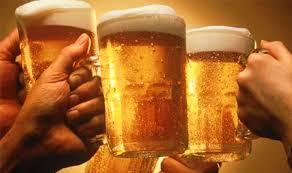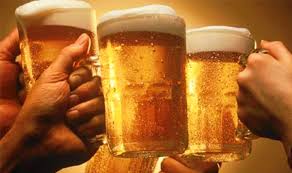
More low and alcohol-free brews to drinkers trying to live a healthier lifestyle is planned to be served by Anheuser-Busch InBev which will soon make almost 30 percent of the world's beer.
Lower and zero strength beer will grow from a small base to make up 20 percent of its sales by the end of 2025, forecasts the Belgium-based brewer which is on the verge of buying its largest rival SABMiller.
For analysts that is a bold target. Although annual growth was 4-6 percent versus just one percent for beer as a whole, industry monitor Plato Logic says beer of up to 2.8 percent alcohol by volume (abv) had only a modest 2.5 percent share in 2014.
Though with limited success, brewers pioneered non-alcoholic beer in the 1980s and 1990s. However this time sustainable consumer demand and a product that actually tastes like regular beer are two factors that could be game changers for the company.
With pilot projects to start in six cities later this year, AB InBev has committed $1 billion to reducing alcohol abuse. The company is best known for its Budweiser, Stella Artois and Corona brands. It will spend far more than that on developing new low alcohol products of up to 3.5 percent, or "no-alcohol" products of 0.5 percent and lower.
Major brewers hope weak beer is a sector where they can rapidly expand as they are faced with the rising challenge from smaller craft brewers and limited growth of mature markets.
"The higher alcohol segment is largely covered by craft. The mainstream boys have decided to go to a segment that is less saturated," said Euromonitor senior drinks analyst Spiros Malandrakis.
As brewers sell non-alcoholic products at the same price or more than a regular beer, but pay far lower or no excise tax, the attraction is clear, with potentially stronger growth and fatter margins.
AB InBev was following consumer trends, with appealing drinks that were also low calorie and made from natural ingredients, Chief Executive Carlos Brito told shareholders in April.
"You have an ocean of opportunity, all these soft drinks, water, juices, energy drinks that today we don't tackle," he said.
The Danish company wanted to be a leader in non-alcoholic beverages, noting more rapid growth in that niche, said Carlsberg chief Cees 't Hart in March.
The new Prohibition Beer is the result of radical changes to the production process, said Charles Nouwen, AB InBev's global director for product development.
Creating a sweet malty brew, previously, brewers had tended to stop fermentation at an early stage. Or cooking a regular beer and risking an oxidized or stale taste, brewers would take a regular beer and heat it up to evaporate the alcohol.
Knowing it would undergo a change when the alcohol was drawn out, Nouwen said that his company had made a base beer that was rounder and richer than a normal Bud while wanting to produce a non-alcoholic beer as close as possible to Budweiser.
While also capturing compounds such as esters and other flavorings that might have escaped, pushing them back into the brew, it removed the alcohol at a far lower temperature by sharply reducing the pressure.
"For lots of consumers we tested with, and even colleagues not involved in tasting panels, we fooled many by mixing some Bud and Bud Prohibition, trying to get them to find which was which. It was not necessarily easy for them," Nouwen said.
Consumers have also changed too since the 1980s when non-alcoholic beer was targeted more at drivers and pregnant women, belives AB InBev and fellow brewers.
"Consumers have evolved, saying they want to have something that is lighter or non-alcoholic for enjoyment... They want to look cool drinking that as part of everyday life with friends," Nouwen said.
(Source:www.reuters.com)
Lower and zero strength beer will grow from a small base to make up 20 percent of its sales by the end of 2025, forecasts the Belgium-based brewer which is on the verge of buying its largest rival SABMiller.
For analysts that is a bold target. Although annual growth was 4-6 percent versus just one percent for beer as a whole, industry monitor Plato Logic says beer of up to 2.8 percent alcohol by volume (abv) had only a modest 2.5 percent share in 2014.
Though with limited success, brewers pioneered non-alcoholic beer in the 1980s and 1990s. However this time sustainable consumer demand and a product that actually tastes like regular beer are two factors that could be game changers for the company.
With pilot projects to start in six cities later this year, AB InBev has committed $1 billion to reducing alcohol abuse. The company is best known for its Budweiser, Stella Artois and Corona brands. It will spend far more than that on developing new low alcohol products of up to 3.5 percent, or "no-alcohol" products of 0.5 percent and lower.
Major brewers hope weak beer is a sector where they can rapidly expand as they are faced with the rising challenge from smaller craft brewers and limited growth of mature markets.
"The higher alcohol segment is largely covered by craft. The mainstream boys have decided to go to a segment that is less saturated," said Euromonitor senior drinks analyst Spiros Malandrakis.
As brewers sell non-alcoholic products at the same price or more than a regular beer, but pay far lower or no excise tax, the attraction is clear, with potentially stronger growth and fatter margins.
AB InBev was following consumer trends, with appealing drinks that were also low calorie and made from natural ingredients, Chief Executive Carlos Brito told shareholders in April.
"You have an ocean of opportunity, all these soft drinks, water, juices, energy drinks that today we don't tackle," he said.
The Danish company wanted to be a leader in non-alcoholic beverages, noting more rapid growth in that niche, said Carlsberg chief Cees 't Hart in March.
The new Prohibition Beer is the result of radical changes to the production process, said Charles Nouwen, AB InBev's global director for product development.
Creating a sweet malty brew, previously, brewers had tended to stop fermentation at an early stage. Or cooking a regular beer and risking an oxidized or stale taste, brewers would take a regular beer and heat it up to evaporate the alcohol.
Knowing it would undergo a change when the alcohol was drawn out, Nouwen said that his company had made a base beer that was rounder and richer than a normal Bud while wanting to produce a non-alcoholic beer as close as possible to Budweiser.
While also capturing compounds such as esters and other flavorings that might have escaped, pushing them back into the brew, it removed the alcohol at a far lower temperature by sharply reducing the pressure.
"For lots of consumers we tested with, and even colleagues not involved in tasting panels, we fooled many by mixing some Bud and Bud Prohibition, trying to get them to find which was which. It was not necessarily easy for them," Nouwen said.
Consumers have also changed too since the 1980s when non-alcoholic beer was targeted more at drivers and pregnant women, belives AB InBev and fellow brewers.
"Consumers have evolved, saying they want to have something that is lighter or non-alcoholic for enjoyment... They want to look cool drinking that as part of everyday life with friends," Nouwen said.
(Source:www.reuters.com)





